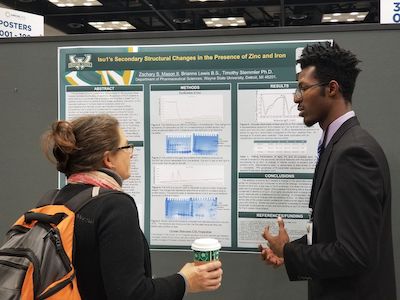Zachary Mason presents Friedreich's Ataxia research at national STEM conference
 Wayne State University biology undergraduate student Zachary Mason II presented his research, “Isu1’s Secondary Structural Changes in the Presence of Zinc and Iron,” at the 2018 Annual Biomedical Research Conference for Minority Students (ABRCMS) in Indianapolis. His work has implications for the treatment of Friedreich’s Ataxia, a severe cardio and neurodegenerative disorder.
Wayne State University biology undergraduate student Zachary Mason II presented his research, “Isu1’s Secondary Structural Changes in the Presence of Zinc and Iron,” at the 2018 Annual Biomedical Research Conference for Minority Students (ABRCMS) in Indianapolis. His work has implications for the treatment of Friedreich’s Ataxia, a severe cardio and neurodegenerative disorder.
“My experience at ABRCMS 2018 was profoundly inspirational,” Mason said. “I was privileged to meet and listen to many passionate researchers and students of various disciplines. In addition, I found it exciting to see other people that are passionate about scientific endeavors and was happy to see faces that looked like mine.”
ABRCMS was designed for underrepresented minorities in science, technology, engineering and mathematics present their research, enhance professional development skills, explore graduate schools, and network. During the four-day conference, over 2,000 students from over 350 colleges and universities participate in poster and oral presentations in twelve STEM disciplines.
Mason is working with Eugene Applebaum College of Pharmacy and Health Sciences Professor of Pharmaceutical Sciences and Associate Dean for Research Tim Stemmler and Ph.D. candidate Brianne Lewis on the project. He is preparing to take the MCAT and plans to apply to M.D./Ph.D. programs.
His attendance at the ABRCMS was funded by the Initiative for Maximizing Student Development (IMSD), a Wayne State program led by Professor of Physiology and Director of Medical Student Research and Innovation Joseph Dunbar. Its mission is to stimulate and facilitate the progress of a diverse group of students toward academic and research careers in biomedical and behavioral sciences.
Since 1978, the IMSD program has supported a total of 671 undergraduate and graduate students. 369 of the undergraduate students have gone on to complete bachelor’s degrees, 81 students have obtained master’s, and 80 have earned doctoral degrees.
“My lab is lucky to have Zach as a member,” Stemmler said. “Not only is he a promising young scientist, but he is a great kid with a lot of enthusiasm and excitement for science. He makes the lab better by providing his insight and understanding to our work, and I am really grateful to Dr. Dunbar and Dr. Zafar for their efforts with the IMSD program since they helped make this happen.”
Abstract
The synthesis of Fe-S clusters is a vital process for life because these clusters facilitate the shuttling of electrons. Biogenesis of Fe-S clusters is performed by a coordinated set of proteins that includes in yeast “Isu1”, a scaffold protein which is central to Fe-S cluster synthesis. Disruption of this important pathway in humans leads to a severe cardio and neurodegenerative disorder known as Friedreich's Ataxia (FRDA). Considering how crucial Fe-S clusters are for organisms to properly function, an accurate model for cluster synthesis is critical for future development of therapeutics to treat FRDA. Circular Dichroism (CD) is a technique used here to analyze the secondary structure of Isu1 by monitoring the protein’s absorption of circularly polarized light. Isu1 has been shown to exist in two states- a structured and disordered state. Here we examine the structure of Isu1 and how it responds to Zn or Fe binding. We have shown that Zn likely stabilizes the structured state of Isu1 as evident by an increase in the helical portion of the protein after addition of Zn. In comparison, Fe does not cause a structural change. These effects contribute to our working model for Fe-S cluster synthesis and how metals are delivered to Isu1.
